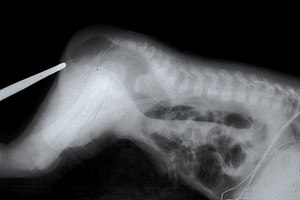Imperforate anus
| Imperforate anus - Anorectal malformations | |
|---|---|
 |
|
| An X-ray showing imperforate anus | |
| Classification and external resources | |
| Specialty | medical genetics |
| ICD-10 | Q42.3 |
| ICD-9-CM | 751.2 |
| OMIM | 301800 207500 |
| DiseasesDB | 34522 |
| MedlinePlus | 001147 |
| eMedicine | ped/1171 ped/2923 |
| MeSH | D001006 |
An imperforate anus or anorectal malformations (ARMs) are birth defects in which the rectum is malformed. ARMs are a spectrum of different congenital anomalies in males and females, that varies from fairly minor lesions to complex anomalies. The cause of ARMs is unknown; the genetic basis of these anomalies is very complex because of their anatomical variability. In 8% of patients genetic factors are clearly associated with ARMs. Anorectal malformation in Currarino syndrome represents the only association for which the gene HLXB9 has been identified.
There are several forms of imperforate anus and anorectal malformations. The new classification is in relation of the type of associated fistula. The classical Wingspread classification was in low and high anomalies:
Imperforate anus is usually present along with other birth defects—spinal problems, heart problems, tracheoesophageal fistula, esophageal atresia, renal anomalies, and limb anomalies are among the possibilities.
Imperforate anus is associated with an increased incidence of some other specific anomalies as well, together being called the VACTERL association:
Other entities associated with an imperforate anus are trisomies 18 and 21, the cat-eye syndrome (partial trisomy or tetrasomy of a maternally derived number 22 chromosome), Baller-Gerold syndrome, Currarino syndrome, caudal regression syndrome, FG syndrome, Johanson-Blizzard syndrome, McKusick-Kaufman syndrome, Pallister-Hall syndrome, short rib-polydactyly syndrome type 1, Townes-Brocks syndrome, 13q deletion syndrome, urorectal septum malformation sequence, and the OEIS complex (omphalocele, exstrophy of the cloaca, imperforate anus, spinal defects).
...
Wikipedia
